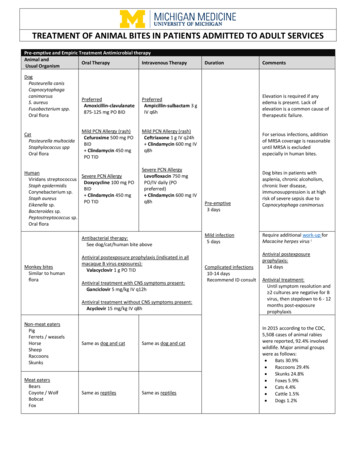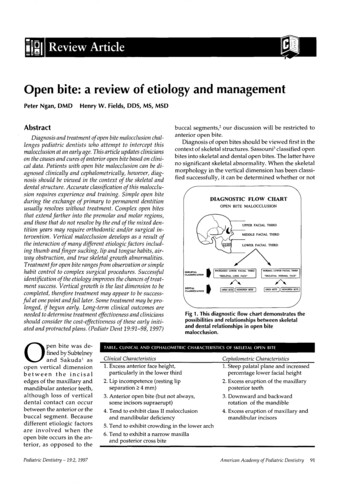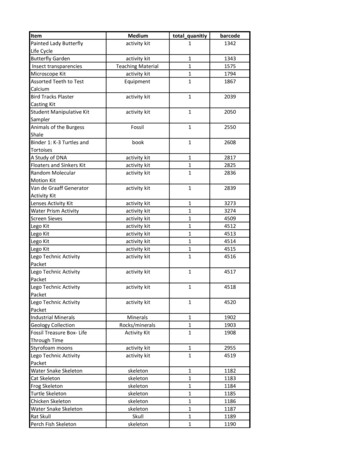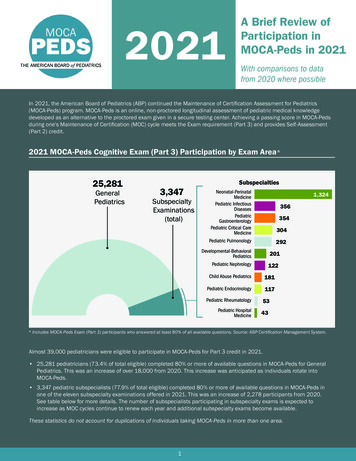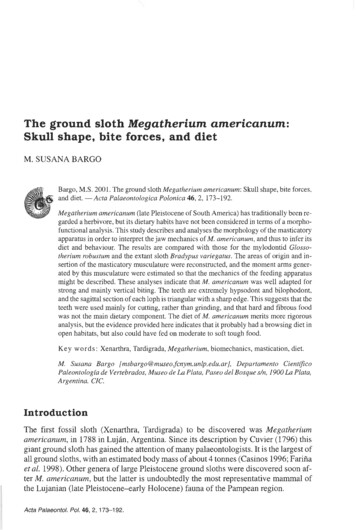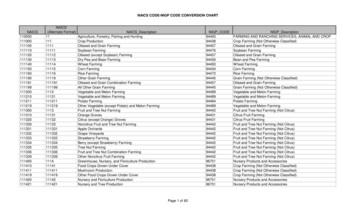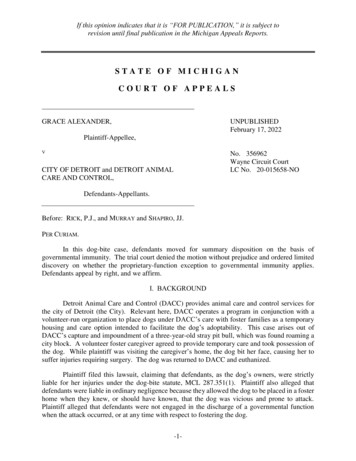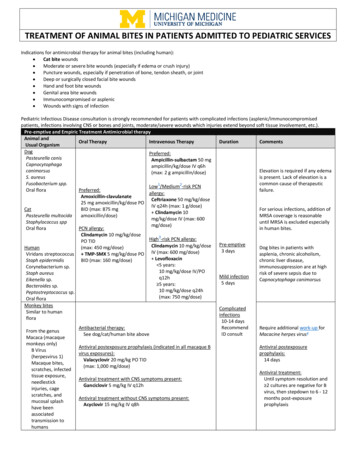
Transcription
TREATMENT OF ANIMAL BITES IN PATIENTS ADMITTED TO PEDIATRIC SERVICESIndications for antimicrobial therapy for animal bites (including human): Cat bite wounds Moderate or severe bite wounds (especially if edema or crush injury) Puncture wounds, especially if penetration of bone, tendon sheath, or joint Deep or surgically closed facial bite wounds Hand and foot bite wounds Genital area bite wounds Immunocompromised or asplenic Wounds with signs of infectionPediatric Infectious Disease consultation is strongly recommended for patients with complicated infections (asplenic/immunocompromisedpatients, infections involving CNS or bones and joints, moderate/severe wounds which injuries extend beyond soft tissue involvement, etc.).Pre-emptive and Empiric Treatment Antimicrobial therapyAnimal andOral TherapyIntravenous TherapyDurationCommentsUsual OrganismDogPreferred:Pasteurella canisAmpicillin-sulbactam 50 mgCapnocytophagaampicillin/kg/dose IV q6hcanimorsusElevation is required if any edema(max: 2 g ampicillin/dose)S. aureusis present. Lack of elevation is aFusobacterium spp.common cause of therapeutic12Low /Medium -risk PCNOral nateCeftriaxone 50 mg/kg/dose25 mg amoxicillin/kg/dose POIV q24h (max: 1 g/dose)CatBID (max: 875 mgFor serious infections, addition of Clindamycin 10Pasteurella multocidaamoxicillin/dose)MRSA coverage is reasonablemg/kg/dose IV (max: 600Staphylococcus sppuntil MRSA is excluded especiallymg/dose)Oral floraPCN allergy:in human bites.Clindamycin 10 mg/kg/doseHigh3-risk PCN allergy:PO TIDPre-emptiveClindamycin 10 mg/kg/doseHuman(max: 450 mg/dose)Dog bites in patients with3 daysViridans streptococcus TMP-SMX 5 mg/kg/dose PO IV (max: 600 mg/dose)asplenia, chronic alcoholism, LevofloxacinStaph epidermidisBID (max: 160 mg/dose)chronic liver disease, 5 years:Corynebacterium sp.immunosuppression are at high10 mg/kg/dose IV/POStaph aureusrisk of severe sepsis due toMild infectionq12hEikenella sp.Capnocytophaga canimorsus5 days 5 years:Bacteroides sp.10 mg/kg/dose q24hPeptostreptococcus sp.(max: 750 mg/dose)Oral floraMonkey bitesSimilar to humanfloraFrom the genusMacaca (macaquemonkeys only)B Virus(herpesvirus 1)Macaque bites,scratches, infectedtissue exposure,needlestickinjuries, cagescratches, andmucosal splashhave beenassociatedtransmission tohumansAntibacterial therapy:See dog/cat/human bite aboveAntiviral postexposure prophylaxis (indicated in all macaque Bvirus exposures):Valacyclovir 20 mg/kg PO TID(max: 1,000 mg/dose)Antiviral treatment with CNS symptoms present:Ganciclovir 5 mg/kg IV q12hAntiviral treatment without CNS symptoms present:Acyclovir 15 mg/kg IV q8hComplicatedinfections10-14 daysRecommendID consultRequire additional work-up forMacacine herpes virus4Antiviral postexposureprophylaxis:14 daysAntiviral treatment:Until symptom resolution and 2 cultures are negative for Bvirus, then stepdown to 6 - 12months post-exposureprophylaxis
Pre-emptive and Empiric Treatment Antimicrobial therapyAnimal andOral TherapyIntravenous TherapyUsual OrganismNon-meat eatersPigFerrets / weaselsHorseSame as dog/cat/humanSame as dog/cat/humanSheepRaccoonsSkunksMeat eatersBearsCoyote / WolfSame as reptilesSame as reptilesBobcatFoxDurationCommentsIn 2015 according to the CDC,5,508 cases of animal rabies werereported, 92.4% involved wildlife.Major animal groups were asfollows: Bats 30.9% Raccoons 29.4% Skunks 24.8% Foxes 5.9% Cats 4.4% Cattle 1.5% Dogs racillin-tazobactam 7525 mg amoxicillin/kg/dose PO mg piperacillin/kg/dose IVBID (max: 875 mgq6hamoxicillin/dose)(max: 4 g piperacillin/dose)Reptiles(Iguana, turtle, lizard)Oral floraSalmonella sppYersinia sppS. marcescensAeromonas sppSnake bites5Oral floraFecal flora ofingested preyStaphylococcus spp.StreptococciEscherichia coliMorganella morganiiEnterococcus faecalisPseudomonasaeruginosaED Snake BiteEnvenomationProtocolLow1/Medium2-risk PCNallergy:Cefpodoxime 5 mg/kg/dosePO BID (max: 400 mg/dose) Metronidazole 10mg/kg/dose PO TID(max: 500 mg/dose)Low1/Medium2-risk PCNallergy:Ceftriaxone 50 mg/kg/doseIV q24h (max: 1 g/dose) Metronidazole 10mg/kg/dose IV q8h(max: 500 mg/dose)Pre-emptive3 daysFor serious infections, addition ofMRSA coverage is reasonableuntil MRSA is excluded.Mild infectionHigh3-risk PCN allergy:High3-risk PCN allergy:5 daysMetronidazole 10Metronidazole 10mg/kg/dose IV q8hmg/kg/dose PO TID(max: 500 mg/dose)(max: 500 mg/dose) Levofloxacin LevofloxacinComplicated 5 years: 5 years:10 mg/kg/dose IV/PO q12h infections10 mg/kg/dose IV/PO q12h10-14 days 5years: 5 years:Recommend10 mg/kg/dose q24h10 mg/kg/dose IV/PO q24hID consult(max: 750 mg/dose)(max: 750 mg/dose)Preferred:Amoxicillin-clavulanate25 mg amoxicillin/kg/dose POBID (max: 875 m 75 Ciprofloxacin 15mg piperacillin/kg/dose IVmg/kg/dose PO BIDq6h(max: 750 mg/dose)(max: 4 g piperacillin/dose)PCN allergy:Ciprofloxacin 15 mg/kg/dosePO BID(max: 750 mg/dose) Metronidazole 10mg/kg/dose PO TID(max: 500 mg/dose) Linezolid 12 years:10 mg/kg/dose PO TID 12 years:600 mg PO BIDPCN AllergyVancomycin per dosingguideline Aztreonam 40 mg/kg/doseIV q8h (max: 2 g/dose) Metronidazole 10mg/kg/dose IV q8h (max:500 mg)Page 2 of 5Only a minority of snake bitesbecome infected and needantibiotics.Antibiotics should be determinedby culture results.Most infections of snakebites areassociated with the introductionof pathogenic bacteria duringattempts at management in thefield.For serious infections, addition ofMRSA coverage is reasonableuntil MRSA is excluded.
Pre-emptive and Empiric Treatment Antimicrobial therapyAnimal andOral TherapyIntravenous TherapyUsual OrganismIf no evidence of infection prophylactic antibiotics can beconsideredPenicillin VK 12 years:Rat15 mg/kg/dose PO QID (max: 500 mg/dose)Streptobacillus 12 years:moniliformis (USA)500 mg PO QIDSpirillium minusOR(Asia)Doxycycline 2.2 mg/kg/dose PO BID (max: 100 mg/dose)If clinical evidence of infectionRecommend IDPenicillin 50,000 units/kg/dose IV q4hconsult for follow up(max: 2 million units/dose)purposesORCeftriaxone 50 mg/kg/dose IV q24h (max: 1 g/dose)ORDoxycycline 2.2 mg/kg/dose PO BID (max: 100 s,Mongooses,Woodchucks,Dogs,Cats,Ferrets,Most othercarnivores7OrganismClostridium tetani(tetanus)Duration3 daysThose vaccinated 5 yearsago with DTaP, Tdap, or Tdrevaccination is not indicatedThose vaccinated 5 years agoor never vaccinated,vaccination is indicatedIf the animal tests positive forrabies or the status is unknownand the animal has a highlikelihood of being a carrier,rabies immune globulin andvaccine can be considered (seeMichigan Rabies Assessmentfor guidance)CommentsUp to 10% of rat bites can lead toinfection.S. moniliformis can also be carriedby hamsters and other laboratoryrodents.Handling of a dead rat has beenreported to cause rat bite fever.Duration10-14 days foruncomplicatedinfectionsEmpiric Vaccination RecommendationsVaccination indicationsContact health departmentfor further direction onanimal containment andtesting (see below text forinstructions)Lyssavirus spp.(rabies)DurationCan observe if decide not to useantibiotics as most patients willpresent within 7 days.Vaccination RecommendationsNever received Tdap:Tdap (ADACEL )IM x1 doseIf previously vaccinated with Tdap:Td (TENIVAC )IM x1 doseIf severe or uncleaned wound and 2 previous vaccines (orunknown vaccination history):Tetanus Immune Globulin (HYPERTET )6250 units IM x1 doseIf immunocompetent and previously unvaccinated with rabiesvaccine:Rabies Immune Globulin20 units/kg infiltrated to the wounds (with remainingadministered IM into the deltoid) x1 dose Human Diploid Rabies Vaccine8IM x4 doses (dosed on days 0, 3, 7, and 14)If immunocompromised and previously unvaccinated with rabiesvaccine:Rabies Immune Globulin20 units/kg infiltrated to the wounds (with remainingadministered IM into the deltoid) x1 dose Human Diploid Rabies Vaccine8IM x5 doses (dosed on days 0, 3, 7, 14, and 28)If previously vaccinated with rabies vaccine9:Human Diploid Rabies Vaccine8IM x2 doses (dosed on days 0 and 3)Further questions can be directed to Infectious Diseases.Page 3 of 5
ACTIONS1. Inform the patient that the animal bite will be reported to the Public Health Department and to Law Enforcement (for purposes of reporting tothe appropriate Animal Control Authorities).2. All animal bites and exposures to bats should be reported to the Washtenaw County Public Health Department (WCPHD) by staff. Completethe attached Animal Bite Report form and fax to WCPHD at (734) 544-6706. Go to WCPHD website for more info:https://www.washtenaw.org/1795/Rabies3. Contact WCPHD at (734)544-6700 for advice regarding sending bats or other animals for rabies testing.4. Hospital Security, Law Enforcement & Animal Control Notification:a. Healthcare provider must report the bite to UMHS Hospital Security by providing Security with the following information: animalbite victim’s name; hospital registration number; date of birth; hospital location/room number.b. Upon notice from health care provider, Hospital Security will dispatch a security officer to obtain the details about the animal biteincident from the animal bite victim. The type of information obtained includes:i. Full Name and address of the victim;ii. Information about the animal (e.g., type of animal, whether wild or domestic pet, etc., as applicable);iii. If known and applicable, name and address of the animal’s owner;iv. Location where the incident occurred;v. Cause, character and extent of the injury;vi. How the incident occurred; andvii. Other related and/or aggravating circumstances regarding the incident (e.g., was animal provoked)c. In cases where a patient or his/her personal representative is not able to provide the information directly to the Hospital SecurityOfficer (e.g., unconscious patient, no personal representative available) the Hospital Security Officer may obtain information aboutthe animal bite (e.g., location, severity, etc.) verbally from the treating health care providers.d. UMHS Hospital Security reports only the animal bite information set forth in Section 4B above to the University of MichiganDepartment of Public Safety (DPS) via phone and security dispatch report (DPS thereafter notifies the appropriate law enforcementagency/animal control officer for the jurisdiction in which the bite occurred).5.Wound management:a. Stabilization/Evaluation – Animal bites should be treated as contusions though they may also have significant lacerations or deeppunctures. Initial treatment with ice and elevation will help reduce swelling. Direct pressure will control actively bleeding wounds.Consideration should be given to potential injury to deep or surrounding structures. A careful neurovascular examination of theinjured area should be performed prior to the instillation of local anesthetics. A musculoskeletal exam should be performed withattention to integrity of deep and adjacent structures. Consider imaging if concern for boney injury or foreign body exists (e.g., plainradiograph or ultrasound). Lacerations over the metacarpophalangeal joints should raise suspicion for possible human bite (i.e., fightbite) injuries.b. Clean wound – Appropriate local anesthesia facilitates adequate wound cleaning. Wounds should be washed with soap and water assoon as possible thorough wound cleaning may help reduce likelihood of rabies transmission.c. Lacerations – To reduce the counts of bacteria present in the wound, the surface should be cleaned with povidone iodine and thedepths irrigated with copious amounts of saline using pressure irrigation from a syringe. Wounds should be explored for foreignbody, or deep structure injury, devitalized tissue should be debrided. Wounds over or near joints should be explored carefullythrough a range of motion to assess for damage to the underlying tendon sheath, fascia, joint capsule, etc.d. Puncture wounds – Inspect wound for evidence of deep puncture, especially if the wound is located in the scalp or near a joint.Remove any foreign bodies or gross wound contaminants. Superficially irrigate the wound, avoiding high pressure irrigation into thewound. Avoid removal of deep tissue (e.g., "coring").e. Wound closure – Closure of a bite wound may increase the risk of infection depending on species inflicting the bite, location, typeand age of wound and host factors. In general, wound closure is discouraged except in locations where cosmetic or functionalimpairment may result. (e.g., facial bite wounds, etc.)Page 4 of 5
References Abrahamian FM, Goldstein EJC. Microbiology of Animal Bite Wound Infections. Clinical Microbiology Reviews. 2011;24(2):231-246. American Academy of Pediatrics. Bite Wounds. In: Kimberlin DW, Brady MT, Jackson MA, Long SS, eds. Red Book : 2015 REPORT OF THECOMMITTEE ON INFECTIOUS DISEASES. American Academy of Pediatrics; 2015; 205-210. American Academy of Pediatrics. Wound Care and Tetanus Prophylaxis. In: Kimberlin DW, Brady MT, Jackson MA, Long SS, eds. RedBook : 2015 REPORT OF THE COMMITTEE ON INFECTIOUS DISEASES. American Academy of Pediatrics; 2015; 202. Chamber, HF, Eliopoulos GM, Gilbert DN, Saag MS. The Sanford Guide to Antimicrobial Therapy 48th edition. Sperryville, VA, USA :Antimicrobial Therapy, Inc, 2018 Cohen JI, Davenport DS, Stewart JA, et al. Recommendations for prevention of and therapy for exposure to B virus (CercopithecineHerpesvirus 1). Clin Infect Dis. (2002) 35 (10): 1191-1203. Geisler WM, Malhotra U, Stamm WE. Bone Marrow Transplant. 2001 Dec;28(12):1171-3. John E. Bennett, Raphael Dolin, Martin J. Blaser. Mandell, Douglas, And Bennett's Principles and Practice of Infectious Diseases 8thedition. Philadelphia, PA : Elsevier/Saunders, 2015. Johns Hopkins ABX Guide, Johns Hopkins Guide. Retrieved ohns Hopkins ABX Guide/540602/all/ About Miami-Dade Fire Rescue Venom Response Program. Special venom considerations. asp Michigan Department of Health and Human Services. Emerging and Zoonotic Infectious Diseases Section. Rabies assessment flowchart. Stevens DL, Bisno AL, Chambers HF, et al. Practice guidelines for the management of skin and soft tissue infections: 2014 update by theInfectious Diseases Society of America. Clin Infect Dis. (2014) 59 (2): e10-e52. University of Michigan Health System Emergency Department Guideline 02-10-131 (UMHS ED Snake Bite Envenomation Protocol) University of Michigan Health System Emergency Department Guideline 02-16-087 (Monkey Bite/Scratch/Exposure Protocol) University of Michigan Health System Emergency Department Policy 02-16.3-014 (Animal Bites, excluding monkeys) Washtenaw County Public Health. Animal bites & bats & rabies. https://www.washtenaw.org/1795/RabiesFootnotes:1. Low-risk: pruritus without rash, remote ( 10 years) unknown reaction, mild rash (self-resolves without additional medical intervention)with no other symptoms, no other symptoms, patient denies allergy but is on record2. Medium-risk: Urticaria/hives with no other symptoms, severe rash with no other symptoms (requires medical intervention and/orrequires ER visit/hospitalization). Severe rash defined as: rash that requires medical intervention (corticosteroids, anti-histamines) and/orrequires ER visit or hospitalization3. High-risk: Any of the following – respiratory symptoms, angioedema, cardiovascular symptoms, anaphylaxis4. Macaque monkey bites require additional workup for Macacine herpesvirus 1 (Herpes Simiae or Herpes B), please see the ED MonkeyBite/Scratch/Exposure Protocol (Macacine herpesvirus 1)5. Snake bites require contact with Michigan Poison Control (1-800-222-1222, ask specifically to speak with the toxicologist). Poison Controltracks available anti-venom supply and can assist in rapidly obtaining appropriate anti-venom. Please see the ED Snake BiteEnvenomation Protocol6. IVIG can be used in place of Tetanus Immune Globulin if Tetanus Immune Globulin is unavailable.7. Bites of squirrels, hamsters, guinea pigs, gerbils, chipmunks, rats, mice and other rodents, rabbits, hares, and pikas almost never requirerabies post-exposure prophylaxis8. Rabies vaccinations should not be administered at or near the same site as the Rabies Immune Globulin. Rabies vaccinations should not beadministered to the gluteal region; may decrease efficacy9. Patients who received post exposure prophylaxis for a previous exposure, people who received a 3-dose, IM pre-exposure regimen, orthose who have a documented adequate rabies virus antibody titer after previous immunization with any vaccine.Antimicrobial Subcommittee Approval: 11/2018, 03/2020Originated:P&T Approval: 12/2018, 05/2020Last Revised:Revision History:03/2020: Aligned recommendations with Adult guideline, added B virus treatmentUnknown03/2020The recommendations in this guide are meant to serve as treatment guidelines for use at Michigan Medicine facilities. If you are an individual experiencing a medicalemergency, call 911 immediately. These guidelines should not replace a provider’s professional medical advice based on clinical judgment, or be used in lieu of anInfectious Diseases consultation when necessary. As a result of ongoing research, practice guidelines may from time to time change. The authors of these guidelineshave made all attempts to ensure the accuracy based on current information, however, due to ongoing research, users of these guidelines are strongly encouraged toconfirm the information contained within them through an independent source.If obtained from a source other than med.umich.edu/asp, please visit the webpage for the most up-to-date document.Page 5 of 5
d. UMHS Hospital Security reports only the animal bite information set forth in Section 4B above to the University of Michigan Department of Public Safety (DPS) via phone and security dispatch report (DPS thereafter notifies the appropriate law enforcement agency/animal control officer for the jurisdiction in which the bite occurred). 5.

